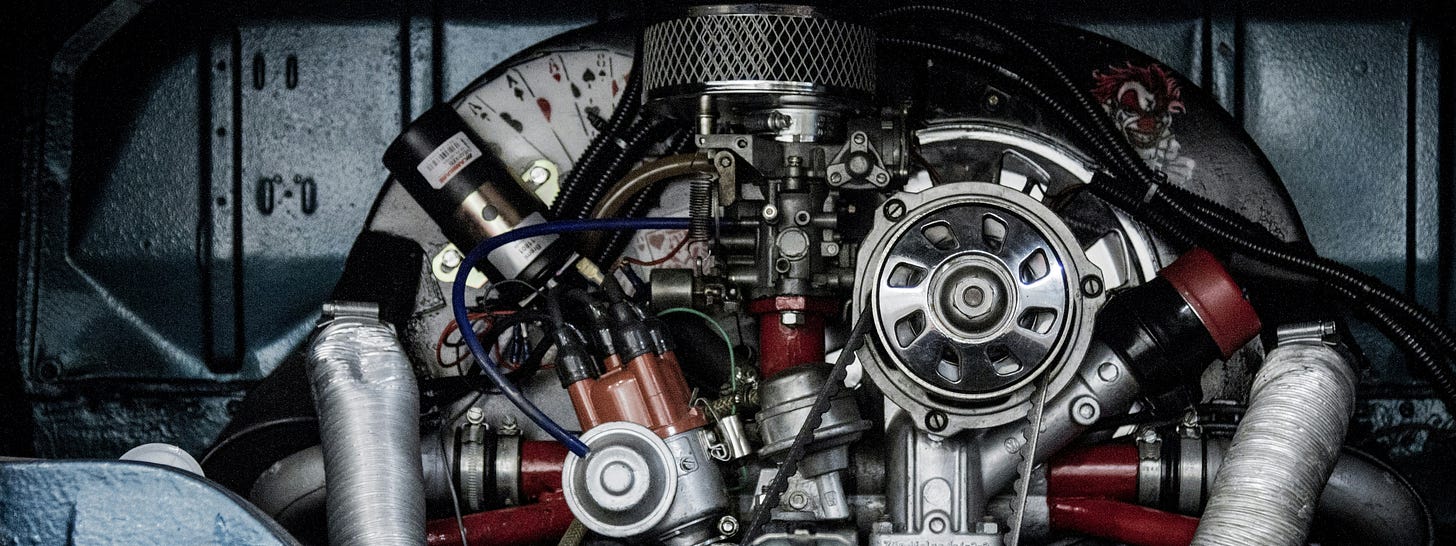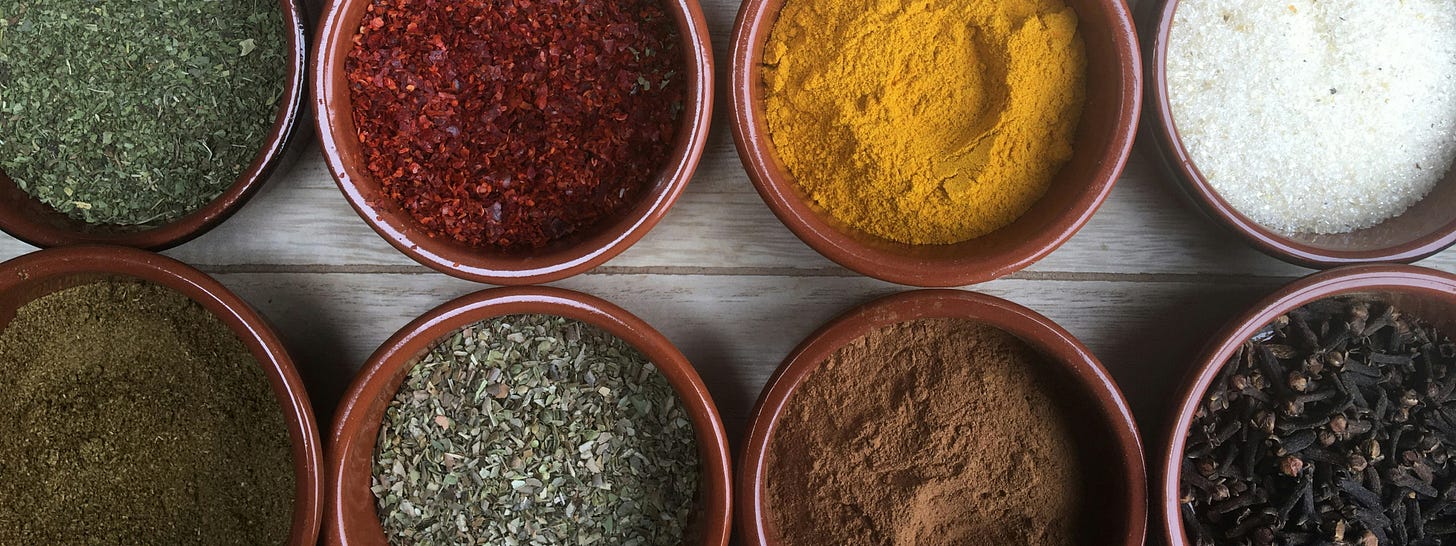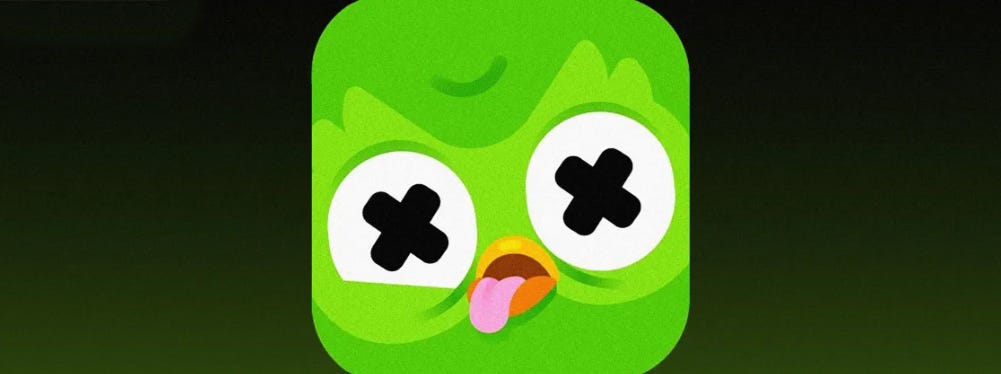Solid soups, endangered owls, and brains turning to mush
Under the hood
Who wants a peek into how Discomfort Zone is created? You? You do? Yes, I’m talking to you! Cool, well, the timing is perfect, because this edition is where I open up the hood so you can see how this bi-weekly engine runs.

As you probably know, I’ve been working full-time with Canada’s National Film Board since early October. Of course, this has put a strain on the production of this newsletter and I’ve been fortunate to have ongoing help from a researcher and writer in Calgary named Silvia Todea. Her responsibility is to suggest potential news items for the FOMO food section towards the end of production week (last week, since the newsletter is programmed on a Sunday for Monday delivery).
Silvia’s suggestions are pulled from a wide range of sources. Most weeks I try to publish at least one story from the global south, but it doesn’t always work out. What’s most important is that I select the three news items that I think align best with Discomfort Zone’s theme: the feedback loop between brands, culture, and tech
As it turns out, this particular edition features a story that encapsulates all three aspects. When you scroll down after reading this behind-the-scenes intro, you’ll see a story about Duolingo’s owl mascot. At first glance, a single tweet (or hoot?) about a brand character wouldn’t seem to have enough depth to base a whole news item on it. But on closer inspection, there seemed to be something more interesting going on. The technology behind language learning apps and their competitors is the new range of powerful Large Language Model (LLM) chatbots that translate in a flash. Then, on the very same day that I read the Duolingo story, I also read a pre-Valentine news item about dedicating dead rats with the name of a disliked ex before they are fed to endangered owls in Western Canada. Wow! It all came together! After the previous weekend’s Superb Owl sporting event, it definitely seemed like nocturnal avian predators were flying high in the cultural zeitgeist.
So, back to the process. Once Silvia has sent over her story drafts, I edit them to make sure they fit with the Discomfort Zone tone (they usually do, she’s good!) and add any details that might spice them up a bit. I also need to source a visual for each story, which is sometimes as simple as cutting and pasting a screenshot, but often requires more research and some photoshopping.

What about the newsletter’s other sections? EARcandy is easy because I subscribe to over 100 podcasts and have an entire second brain devoted to listening to them. I’ve built up a collection of episodes that might appeal to my readers, all ready and waiting in a document.
The way the world is right now, there’s never a shortage of DISScomfort items on hand and the YOURsay tail section is where I place a fun snippet or ask a question to find out what you guys think.
I find or create images to illustrate all of the pieces and credit them appropriately. Then comes the most fun part in the entire process of creating Discomfort Zone: writing image captions. I could do it all day long! By the way, I used to create images for the newsletter using AI tools such as Dall-E and Midjourney but rarely do so now due to concerns over intellectual property theft by the companies that own those platforms.
Once a draft of the newsletter is complete, I put it through a grammar and spell-checking platform and then lay it out in the Substack template. Finally, I give the whole thing another read-through to catch any errors that slipped past the software, and make last-minute adjustments to the text.
By this point it’s usually Sunday afternoon or evening, so I create the SEO tags that help Discomfort Zone reach a wider audience and program it to be delivered to inboxes before 9 a.m. on a Monday morning. I can then slip into the comfort zone known as “bed”, happy in the knowledge that I’ve made the world a more uncomfortable place. You’re welcome.
Soup you can suck
People like clear categories, especially when it comes to food and drinks. Bread is fine, toast is fine, but floppy toast is disappointing. Iced coffee is great, steaming latte is nice, but a lukewarm coffee is meh. And let’s not forget the world’s primary example of cultural polarization: is a hot dog a sandwich?
But sometimes the key to marketing a product is to create a niche from a unique blend of categories: take Cirque du Soleil’s defining combination of acrobatics, storytelling, and gymnastics, for example.
So… can a savory flavor and hard candy combine to create a new sort of sucker? It turns out that soup can… and does!
Progresso, a canned soup company, released their chicken-soup-flavored Soup Drops just last month, and their first batch sold out within an hour. This prompted a few more weekly releases, also disappearing faster than you can eat a bowl of real soup. Sales were souper successful, so much so that the Progresso Soup Drop site crashed multiple times, leaving eager buyers steaming in the Instagram comments.
But why does this mix of categories work so well? Although “hard candy/cough drops” and “savory flavors” belong to separate categories of food, both belong to the same category of cold/flu cures. This year’s flu cases have been their highest since 2009, possibly boosting the soup drops’ appeal. There’s something off-puttingly charming about the efficiency of getting to “drink” chicken soup and suck on a cough drop while lying in bed recovering or stuck being out and about in public.
Duolingo Owl, RIP
No more passive-aggressive notifications to lure you into language learning: the Duolingo Owl died on February 11, as announced by the app on X. The mascot’s eyes are officially X’ed out on all Duolingo’s social media profile pictures, and dead Duolingo merch (including a casket for your Duolingo skeleton plushy) is available for purchase.
It’s safe to say that the app is leaning hard into the “unhinged” side of its self-described “wholesome and unhinged” brand strategy. But does this death go deeper than a social media stunt?
Duolingo posted a video of the mascot getting hit by a Tesla Cybertruck as Duolingo’s official cause of death. Elon Musk responded indirectly when X posted a picture of both the Twitter logo and the Duolingo bird rising to Heaven, with the caption, “all birds go to Heaven.”
The metaphorical implications of Musk’s tech-fueled birdicide need no explanation. Perhaps Musk’s association with AI also feeds into this metaphor, as Duolingo faced criticism for its subpar AI-powered features and for replacing 10% of its contracted translators with AI over the past year in an effort to compete with other AI language-learning apps and chatbots. Whatever the underlying message behind the owl obit, Duolingo may not survive much longer, faced with the surge of AI-driven competitors.
NYC’s love letters
Sometimes a good idea trumps a big budget and brand name. Over 500 people in NYC wrote love letters and deposited them into one of a dozen red mailboxes for a local florist’s Valentine’s Day Love Letters of New York City campaign. Kelsie Hayes, founder of Popup Florist, was “blown away” by the campaign’s response: poems, letters to past loves, letters to New York City, and cute cards from kids were collected between January 23 and 30.
Valentine’s Day certainly lends itself to effective and engaging marketing campaigns, which makes sense given the marketing-driven existence of the holiday itself.
In a less heart-warming direction, anti-love campaigns also took off this year. Zoos and animal shelters offered ways to exact symbolic revenge on an ex, often for charity. For example, the Northern Spotted Owl Breeding Program in British Colombia’s No regRATS campaign promised a photo of a rat, named after an ex, being eaten by an owl for a $5 donation. Other organizations offered the chance to name a feral cat after your ex and help pay its neutering fee, or feed a wildcat a treat representing your ex’s heart.
Whether sentimental or salty, Valentine’s Day campaigns that allow people to express how they really feel seem to be the key to their hearts and wallets.
David Ogilvy, advertising legend
“Look for people who will aim for the remarkable, who will not settle for the routine.”
David Ogilvy was a Brit who made his mark in the US by founding Ogilvy & Mather, one of the greatest advertising agencies of the twentieth century, and still a major force in the industry. Ogilvy brought advertising theory and practice to mainstream audiences with his 1983 book Ogilvy on Advertising, even promoting it in laconic fashion on David Letterman’s late-night talkshow.
Despite his undeniable success, Ogilvy never claimed to possess the secret sauce for building a great ad campaign. He believed in testing and learning, and, as the quote above demonstrates, also knew that creative ambition is the key to standing out in a crowded field.
Welcome to the OmniHuman future
If ever a word better captures the intent underpinning section of my newsletter than “omnihuman”, I haven’t encountered it yet. While Deepseek got the world’s attention at the start of the year and freaked out US-led artificial intelligence firms by creating a competitive LLM tool with a fraction of the effort and expense, the publication of a paper by Chinese TikTok owner ByteDance earlier this month has gone largely unnoticed. Although not yet available to the public, the paper announced the development of a sophisticated AI video creation tool called OmniHuman.
What makes OmniHuman simultaneously so impressive, fun, and horrifying? With the input of a single image (an illustration, a photo, or a video) the software is able to produce a thoroughly convincing video clip that also includes synched audio, such as talking or singing. It supports images of any aspect ratio, whether portraits, half-body, or full-body images. The fabricated video featuring Albert Einstein that has been released by OmniHuman is a fun example. What lies more toward the horrifying end of the spectrum is a clip of a faked TED-talk-style video that is utterly believable.
Although OmniHuman isn’t available to the public at the moment, you can bet your bottom renminbi that it will be soon. I expect it to be integrated with TikTok or at least be available as a plugin similar to ByteDance’s CapCut editing software. This will then put the ability to create perfect fake videos in the pockets of everyone with a smartphone. Fun times ahead.
brAIn mush?
404 Media is a small band of four indie journalists who used to work for mainstream media. Their company publishes a website featuring tech-science-business-politics news and investigative pieces, as well as a weekly eponymous podcast where they bring additional editorial commentary to subjects that require extra discussion.
The first section of 404’s most recent podcast episode is called AI is Breaking Our Brains. Although the title makes it sound like an opinion piece, it’s actually inspired by a research paper published last week by Microsoft which looks at how using AI tools might be affecting the human brain. The TL;DR is that by outsourcing the boring stuff to AI, parts of our brains might be getting weaker, in the same way that muscles shrink if not used enough.
The paper, titled The Impact of Generative AI on Critical Thinking: Self-Reported Reductions in Cognitive Effort and Confidence Effects From a Survey of Knowledge Workers, points out that a “key irony of automation is that by mechanising routine tasks and leaving exception-handling to the human user, you deprive the user of the routine opportunities to practice their judgement and strengthen their cognitive musculature, leaving them atrophied and unprepared when the exceptions do arise.” In other words, even the boring stuff keeps your mind fit, so use it or lose it.
Panics that cognitive decline will result from the use of new technology have occurred frequently in recent decades alongside the introduction of pocket calculators, online search, and GPS navigation. Reality has not borne out these fears. But it is telling that a company which makes AI products has raised a red flag about the mental downsides to using them. Another hugely ironic observation made by the podcasters is that one of Microsoft’s AI competitors, Anthropic, instructs job seekers looking to work for them not to use AI when writing their applications.
Spring break break
The next issue of Discomfort Zone was originally planned for March 3, but I’ll be away on a spring break family vacation so I’ll be back on your screens March 17. If you’re going away too, have fun!
Did you enjoy this issue of Discomfort Zone? You can comment directly in the Substack app or drop me a line by emailing me at john@johnbdutton.com.
And why not connect with me on LinkedIn if you haven’t already?
FOMO food research and writing by Silvia Todea, editing by John Dutton.
Legal disclaimers:
All images in this newsletter that are not the property of the author are used with permission or reproduced under the fair use provisions of the Canadian Copyright Act while giving appropriate credit.
The content published in this newsletter represents the private views and opinions of John B. Dutton and are not in any way connected to his role with the National Film Board of Canada.















